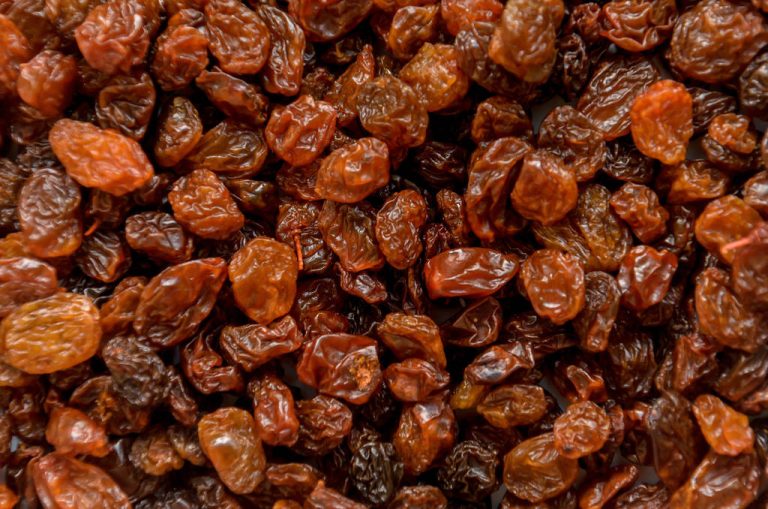Raisins, sultanas or currants – have you ever stood in front of the shelves in the supermarket or health food store and didn’t know what to take? We will explain the differences to you.
Raisins, sultanas and currants: A question of the grape variety

While raisins and sultanas come from the same grape variety and differ only in the way they are dried, currants are a completely different variety. The main differences:
Sultanas and raisins are made from the seedless, thin-skinned and particularly sweet white Sultana grape. She mostly comes from Turkey.
Smaller, purple-black grapes are used for currants. These come from Greece, preferably near Corinth – hence the name (from Greek “Korinthiaki”).
All of these dried grape varieties are now grown in other countries such as Australia, South Africa and the United States (California). Therefore, you should pay attention to the origin when buying to avoid long transport routes.
With the variety of labels on the supermarket shelf, however, the question can sometimes arise: What are raisins? If you refer to dried grapes as “raisins” regardless of their variety or drying method, that’s not wrong. It is also the common generic term for all dried grapes.
Difference between raisins and sultanas: the drying process
Depending on the drying process, the Sultana grape becomes a raisin or a sultana:
Sultanas are characterized by a special step before drying: they are dipped. That is, they are sprayed with a solution of potash and olive oil.
This loosens the wax layer on the outer shell and the fruit becomes permeable to water. This reduces the drying time to three to five days. What is left of the 95 percent water content is a light-colored, shriveled berry.
Instead, raisins dry in the sun between five and seven days and darken slightly.
Incidentally, all grapes are dried using the same method: After harvesting, the berries are hung up or placed on special drying tarpaulins. After that, the grapes only retain about 15 to 18 percent of their original water content.
In the further processing, the stalks are detached from the berries by shaking, berries that are too small are sieved out and the now brown and shriveled grapes are washed again. After drying again, the berries are usually treated with sunflower oil to prevent them from sticking together.
Are sultanas & co healthy?
Just like raisins, sultanas are healthy when consumed in moderation. They provide you with B vitamins, potassium and iron. Incidentally, your body only absorbs the latter well in combination with vitamin C, for example with peppers or citrus fruits. Currants also contain a lot of magnesium, as well as zinc and calcium.
However, the following applies to all dried grapes: They consist of around half (fruit) sugar and are correspondingly calorie bombs.
Raisins and sultanas: sulphurised or unsulphurised?
Raisins and sultanas are often sulphurised during their production to make them more durable. This must be noted on the packaging from an addition of ten milligrams per kilo. Sulfurizing means either burning sulfur to form sulfur dioxide or adding sulphur-containing compounds. However, the former is an outdated method.
Sulfurized dried fruit can sometimes cause nausea or headaches. The process also destroys the vitamin B1 it contains.
Although sulfur has an antibacterial effect and prevents fungal attack, it is not necessary from an ecological point of view to make the fruit last longer.
Therefore, when in doubt, it is advisable to reach for – usually – unsulphured and untreated organic dried fruit, for example these organic sultanas** or organic currants from Demeterhof.
By the way: Currants are usually always unsulphured. In the case of sultanas and raisins, you can recognize the sulfur from the darker color – and of course from the note on the packaging.
What should you consider when buying raisins?
You found European, unsulphured, organic raisins on the shelf? Then there is really only one consideration: How can you avoid as much plastic packaging as possible? Dried fruits have a long shelf life due to their low water content – provided they are dry and packaged reasonably airtight. Therefore, you are welcome to use the slightly larger storage pack.
Tip: Raisins are also often available in so-called unpackaged shops, where you can fill the right amount directly into the box you brought with you. Find out where the nearest unpackaged store is and stop by there for your next purchase.
Cook and bake with raisins, sultanas and currants

You can cook with raisins all year round. For example, try raisin cake, sugar-free raisin rolls, homemade broken chocolate with dried grapes or an apple and orange raw food tart as a dessert for the vegetarian Christmas menu.
Sultanas go particularly well with Namoura, the Lebanese semolina cake.
Dried grapes also go well with hearty dishes: they add a sweet note to couscous salads, lentil salads, bulgur recipes, or recipes with pointed cabbage. Slightly tart raisins and currants go well with a fruity fruit salad or mujadarra, a vegan lentil dish.








